Health Advancement and Promotion: CVD Prevention in Australia Report
VerifiedAdded on 2021/09/10
|27
|5171
|97
Report
AI Summary
This report proposes a public intervention aimed at preventing Cardiovascular Diseases (CVD) in Australia, which are major contributors to mortality. The intervention focuses on setting goals and objectives, planning strategies, and identifying evaluation methods to prevent CVD. The research addresses the importance of this health outcome and includes a budget of $200,000 over three years. The objectives are to raise awareness about CVD prevention and provide evidence for policymakers and researchers. The report includes background information, literature review, study methods (survey design, sampling, and data collection), ethical considerations, data analysis, an action plan, anticipated outcomes, evaluation strategies, timeline, and budget justification. The research emphasizes the need for public interventions to monitor risk factors like obesity, high blood pressure, and physical inactivity, as well as the importance of health promotion and healthcare services in mitigating these risks. The report also highlights the need for economic evaluations to guide policy decisions and allocate resources effectively, especially for vulnerable populations like Indigenous Australians.

Running head: Health Advancement and Promotion
Health Advancement and Promotion
Health Advancement and Promotion
Paraphrase This Document
Need a fresh take? Get an instant paraphrase of this document with our AI Paraphraser
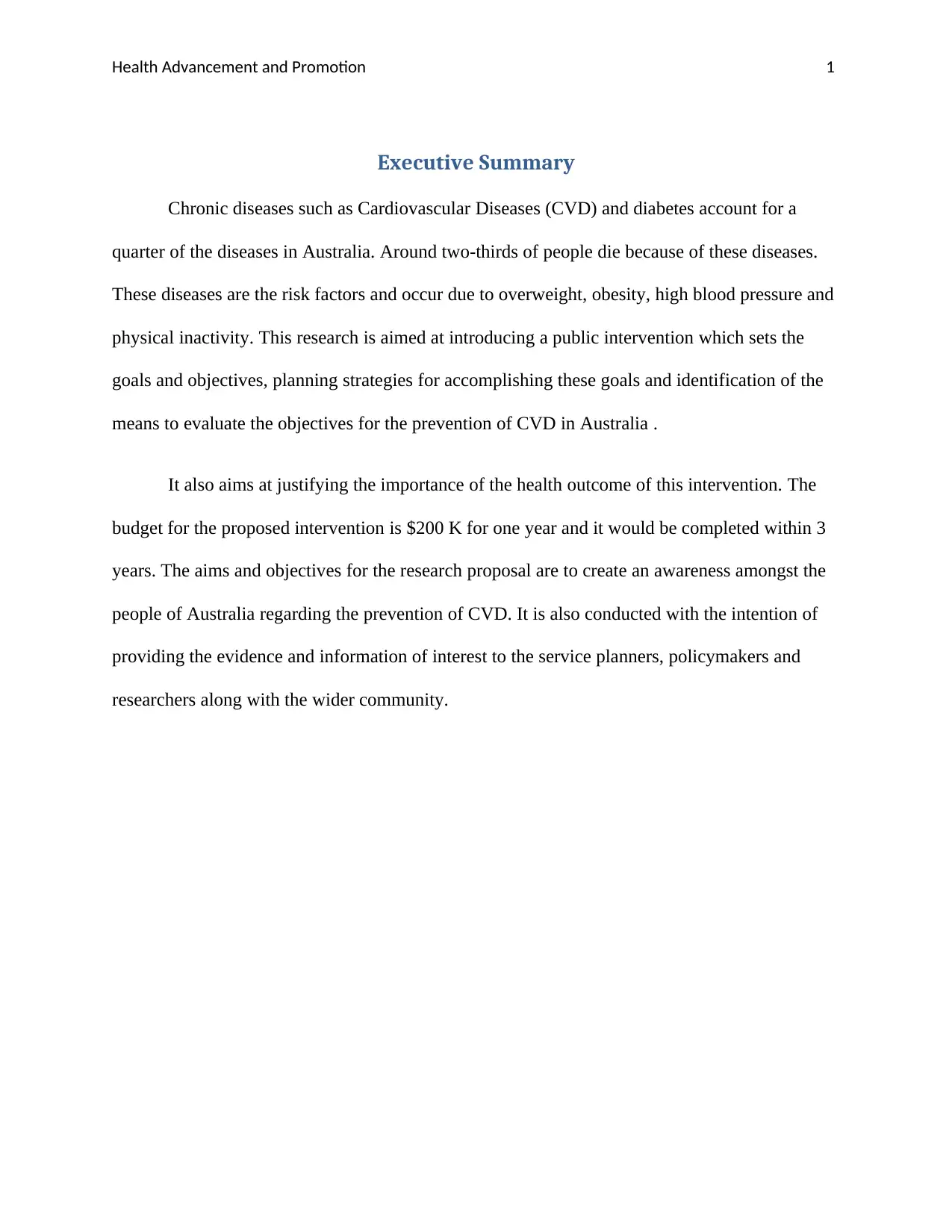
Health Advancement and Promotion 1
Executive Summary
Chronic diseases such as Cardiovascular Diseases (CVD) and diabetes account for a
quarter of the diseases in Australia. Around two-thirds of people die because of these diseases.
These diseases are the risk factors and occur due to overweight, obesity, high blood pressure and
physical inactivity. This research is aimed at introducing a public intervention which sets the
goals and objectives, planning strategies for accomplishing these goals and identification of the
means to evaluate the objectives for the prevention of CVD in Australia .
It also aims at justifying the importance of the health outcome of this intervention. The
budget for the proposed intervention is $200 K for one year and it would be completed within 3
years. The aims and objectives for the research proposal are to create an awareness amongst the
people of Australia regarding the prevention of CVD. It is also conducted with the intention of
providing the evidence and information of interest to the service planners, policymakers and
researchers along with the wider community.
Executive Summary
Chronic diseases such as Cardiovascular Diseases (CVD) and diabetes account for a
quarter of the diseases in Australia. Around two-thirds of people die because of these diseases.
These diseases are the risk factors and occur due to overweight, obesity, high blood pressure and
physical inactivity. This research is aimed at introducing a public intervention which sets the
goals and objectives, planning strategies for accomplishing these goals and identification of the
means to evaluate the objectives for the prevention of CVD in Australia .
It also aims at justifying the importance of the health outcome of this intervention. The
budget for the proposed intervention is $200 K for one year and it would be completed within 3
years. The aims and objectives for the research proposal are to create an awareness amongst the
people of Australia regarding the prevention of CVD. It is also conducted with the intention of
providing the evidence and information of interest to the service planners, policymakers and
researchers along with the wider community.
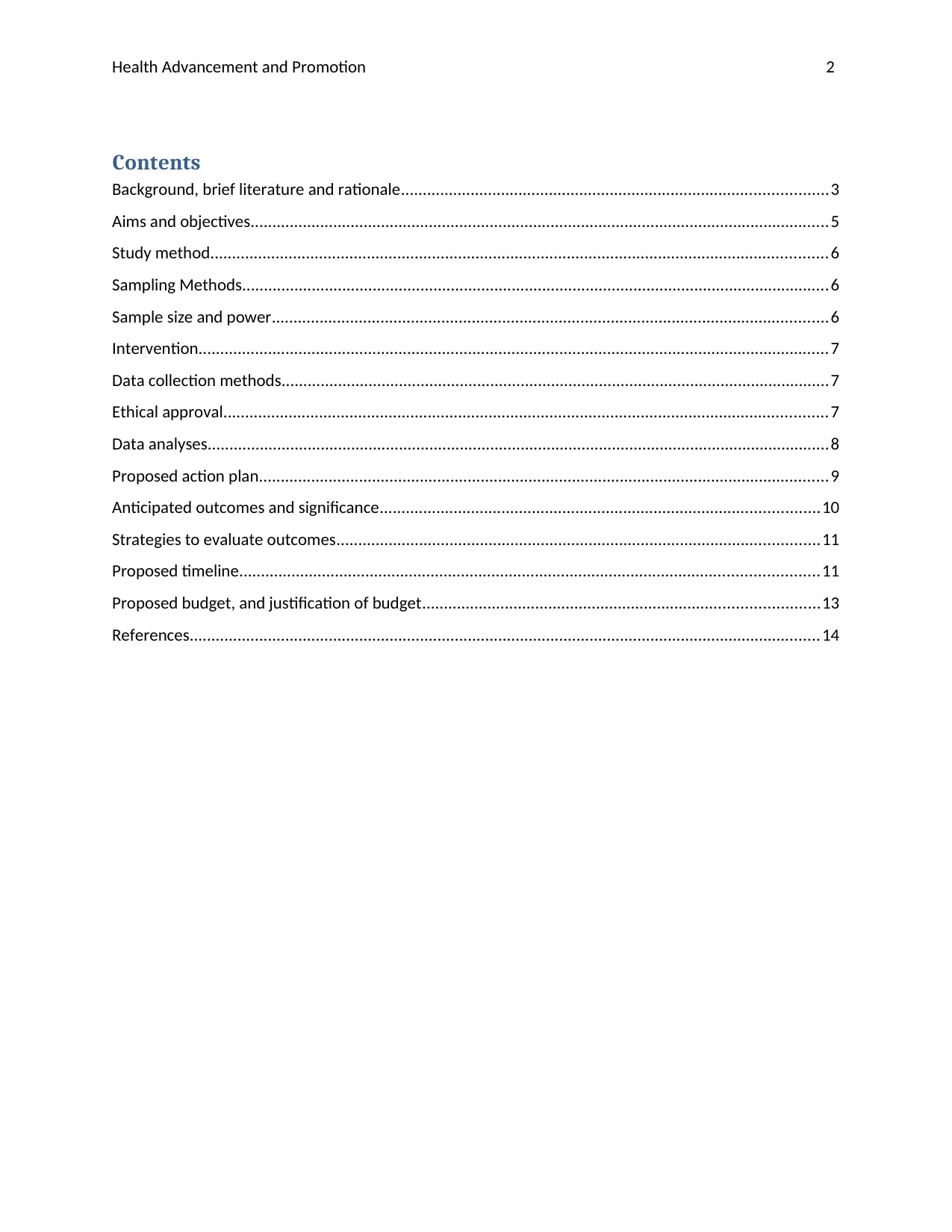
Health Advancement and Promotion 2
Contents
Background, brief literature and rationale..................................................................................................3
Aims and objectives.....................................................................................................................................5
Study method..............................................................................................................................................6
Sampling Methods.......................................................................................................................................6
Sample size and power................................................................................................................................6
Intervention.................................................................................................................................................7
Data collection methods..............................................................................................................................7
Ethical approval...........................................................................................................................................7
Data analyses...............................................................................................................................................8
Proposed action plan...................................................................................................................................9
Anticipated outcomes and significance.....................................................................................................10
Strategies to evaluate outcomes...............................................................................................................11
Proposed timeline.....................................................................................................................................11
Proposed budget, and justification of budget...........................................................................................13
References.................................................................................................................................................14
Contents
Background, brief literature and rationale..................................................................................................3
Aims and objectives.....................................................................................................................................5
Study method..............................................................................................................................................6
Sampling Methods.......................................................................................................................................6
Sample size and power................................................................................................................................6
Intervention.................................................................................................................................................7
Data collection methods..............................................................................................................................7
Ethical approval...........................................................................................................................................7
Data analyses...............................................................................................................................................8
Proposed action plan...................................................................................................................................9
Anticipated outcomes and significance.....................................................................................................10
Strategies to evaluate outcomes...............................................................................................................11
Proposed timeline.....................................................................................................................................11
Proposed budget, and justification of budget...........................................................................................13
References.................................................................................................................................................14
⊘ This is a preview!⊘
Do you want full access?
Subscribe today to unlock all pages.

Trusted by 1+ million students worldwide
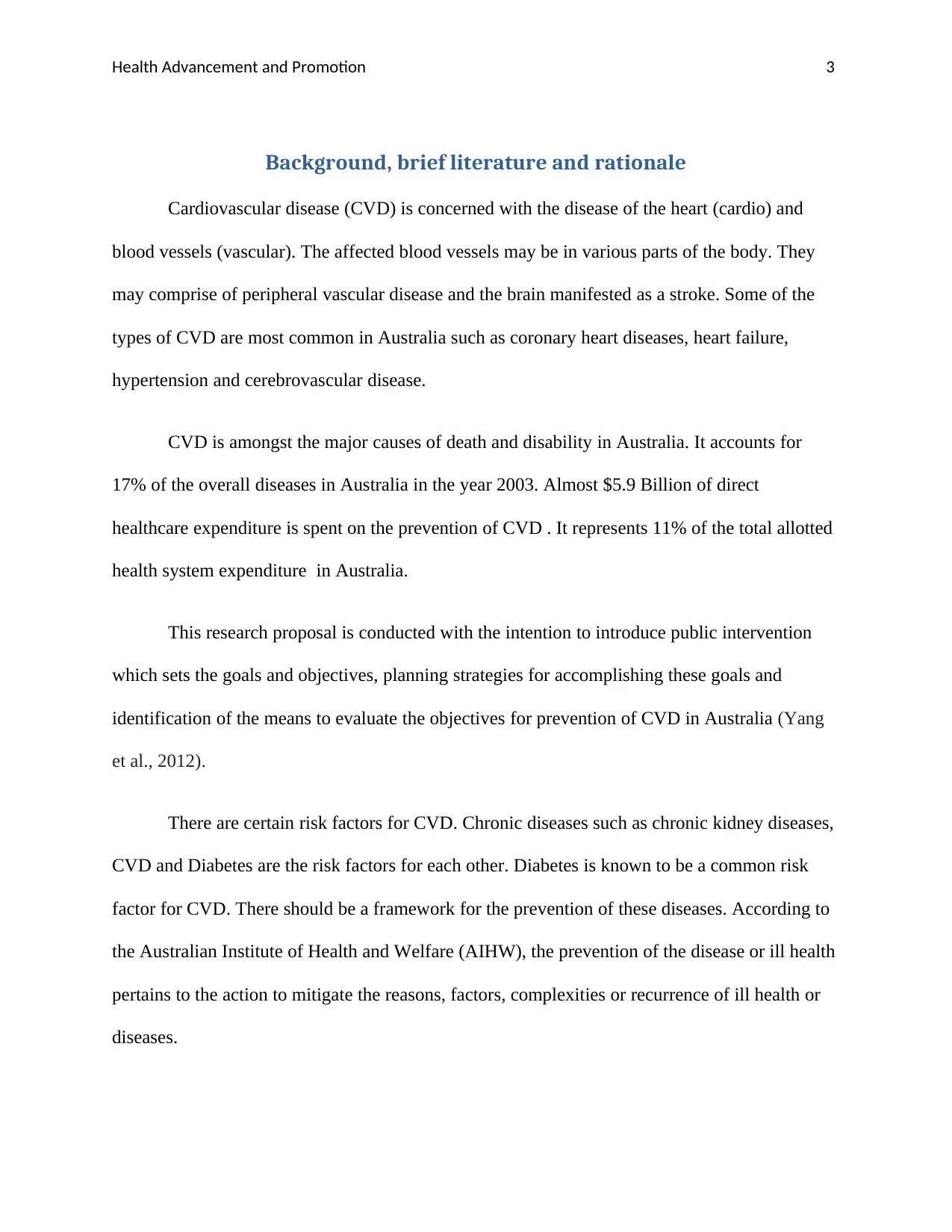
Health Advancement and Promotion 3
Background, brief literature and rationale
Cardiovascular disease (CVD) is concerned with the disease of the heart (cardio) and
blood vessels (vascular). The affected blood vessels may be in various parts of the body. They
may comprise of peripheral vascular disease and the brain manifested as a stroke. Some of the
types of CVD are most common in Australia such as coronary heart diseases, heart failure,
hypertension and cerebrovascular disease.
CVD is amongst the major causes of death and disability in Australia. It accounts for
17% of the overall diseases in Australia in the year 2003. Almost $5.9 Billion of direct
healthcare expenditure is spent on the prevention of CVD . It represents 11% of the total allotted
health system expenditure in Australia.
This research proposal is conducted with the intention to introduce public intervention
which sets the goals and objectives, planning strategies for accomplishing these goals and
identification of the means to evaluate the objectives for prevention of CVD in Australia (Yang
et al., 2012).
There are certain risk factors for CVD. Chronic diseases such as chronic kidney diseases,
CVD and Diabetes are the risk factors for each other. Diabetes is known to be a common risk
factor for CVD. There should be a framework for the prevention of these diseases. According to
the Australian Institute of Health and Welfare (AIHW), the prevention of the disease or ill health
pertains to the action to mitigate the reasons, factors, complexities or recurrence of ill health or
diseases.
Background, brief literature and rationale
Cardiovascular disease (CVD) is concerned with the disease of the heart (cardio) and
blood vessels (vascular). The affected blood vessels may be in various parts of the body. They
may comprise of peripheral vascular disease and the brain manifested as a stroke. Some of the
types of CVD are most common in Australia such as coronary heart diseases, heart failure,
hypertension and cerebrovascular disease.
CVD is amongst the major causes of death and disability in Australia. It accounts for
17% of the overall diseases in Australia in the year 2003. Almost $5.9 Billion of direct
healthcare expenditure is spent on the prevention of CVD . It represents 11% of the total allotted
health system expenditure in Australia.
This research proposal is conducted with the intention to introduce public intervention
which sets the goals and objectives, planning strategies for accomplishing these goals and
identification of the means to evaluate the objectives for prevention of CVD in Australia (Yang
et al., 2012).
There are certain risk factors for CVD. Chronic diseases such as chronic kidney diseases,
CVD and Diabetes are the risk factors for each other. Diabetes is known to be a common risk
factor for CVD. There should be a framework for the prevention of these diseases. According to
the Australian Institute of Health and Welfare (AIHW), the prevention of the disease or ill health
pertains to the action to mitigate the reasons, factors, complexities or recurrence of ill health or
diseases.
Paraphrase This Document
Need a fresh take? Get an instant paraphrase of this document with our AI Paraphraser
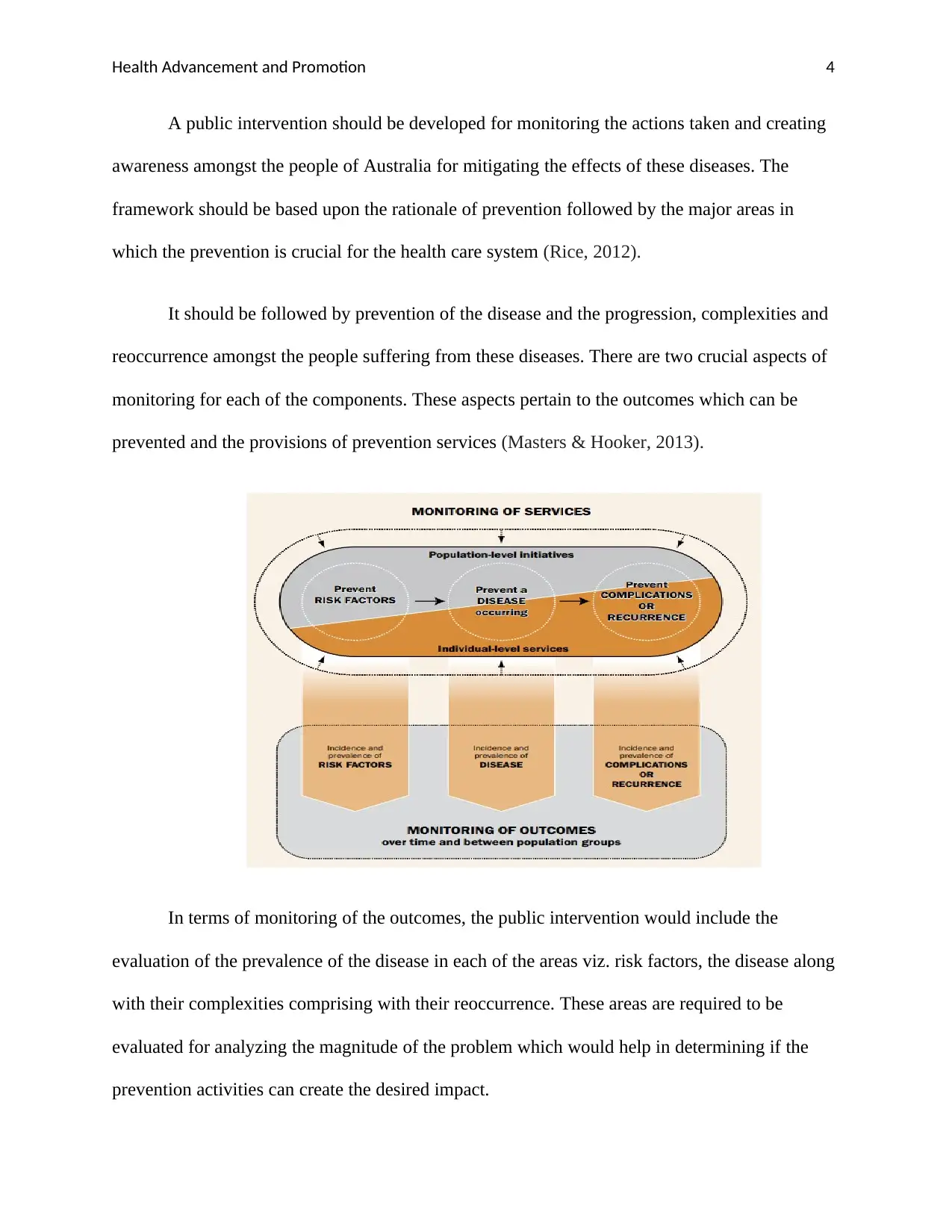
Health Advancement and Promotion 4
A public intervention should be developed for monitoring the actions taken and creating
awareness amongst the people of Australia for mitigating the effects of these diseases. The
framework should be based upon the rationale of prevention followed by the major areas in
which the prevention is crucial for the health care system (Rice, 2012).
It should be followed by prevention of the disease and the progression, complexities and
reoccurrence amongst the people suffering from these diseases. There are two crucial aspects of
monitoring for each of the components. These aspects pertain to the outcomes which can be
prevented and the provisions of prevention services (Masters & Hooker, 2013).
In terms of monitoring of the outcomes, the public intervention would include the
evaluation of the prevalence of the disease in each of the areas viz. risk factors, the disease along
with their complexities comprising with their reoccurrence. These areas are required to be
evaluated for analyzing the magnitude of the problem which would help in determining if the
prevention activities can create the desired impact.
A public intervention should be developed for monitoring the actions taken and creating
awareness amongst the people of Australia for mitigating the effects of these diseases. The
framework should be based upon the rationale of prevention followed by the major areas in
which the prevention is crucial for the health care system (Rice, 2012).
It should be followed by prevention of the disease and the progression, complexities and
reoccurrence amongst the people suffering from these diseases. There are two crucial aspects of
monitoring for each of the components. These aspects pertain to the outcomes which can be
prevented and the provisions of prevention services (Masters & Hooker, 2013).
In terms of monitoring of the outcomes, the public intervention would include the
evaluation of the prevalence of the disease in each of the areas viz. risk factors, the disease along
with their complexities comprising with their reoccurrence. These areas are required to be
evaluated for analyzing the magnitude of the problem which would help in determining if the
prevention activities can create the desired impact.
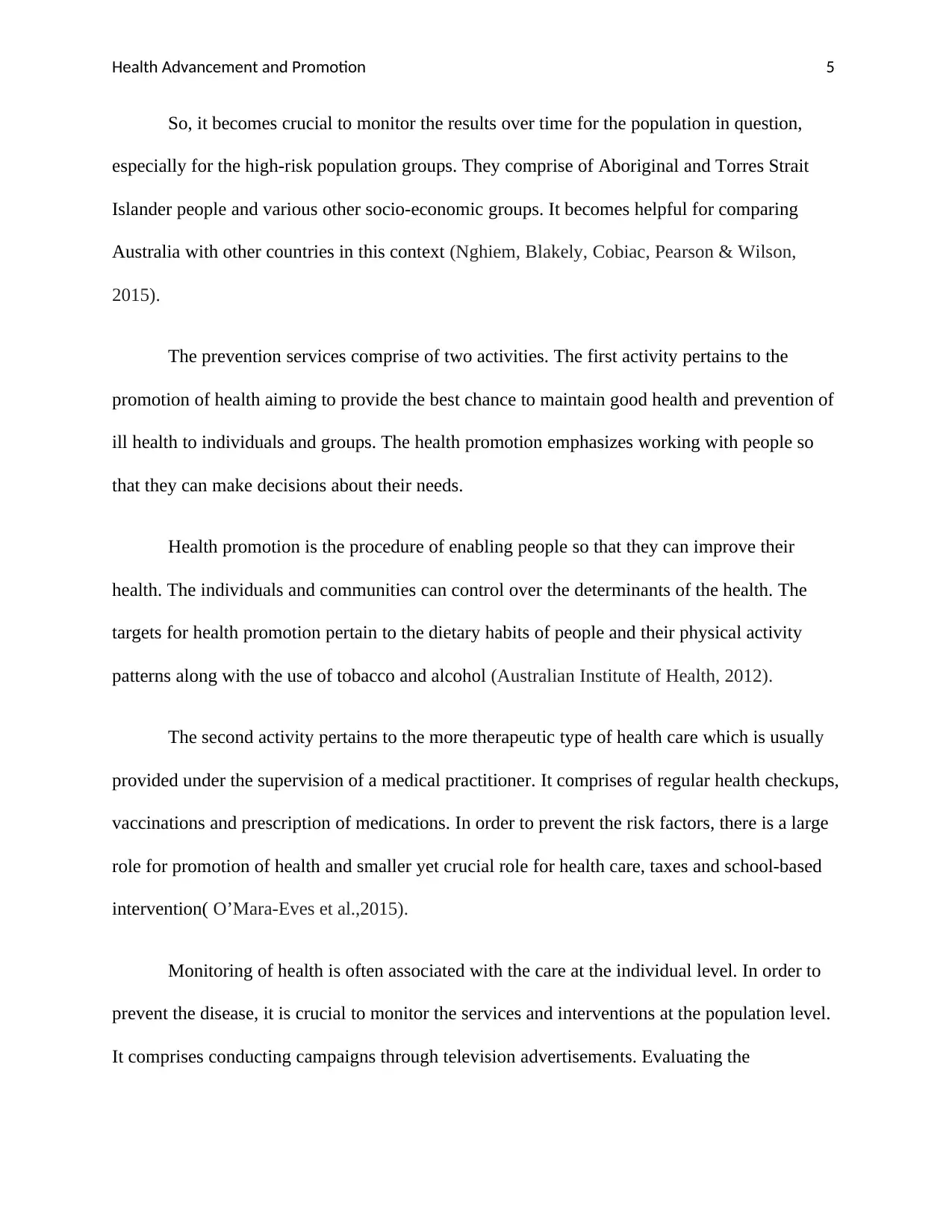
Health Advancement and Promotion 5
So, it becomes crucial to monitor the results over time for the population in question,
especially for the high-risk population groups. They comprise of Aboriginal and Torres Strait
Islander people and various other socio-economic groups. It becomes helpful for comparing
Australia with other countries in this context (Nghiem, Blakely, Cobiac, Pearson & Wilson,
2015).
The prevention services comprise of two activities. The first activity pertains to the
promotion of health aiming to provide the best chance to maintain good health and prevention of
ill health to individuals and groups. The health promotion emphasizes working with people so
that they can make decisions about their needs.
Health promotion is the procedure of enabling people so that they can improve their
health. The individuals and communities can control over the determinants of the health. The
targets for health promotion pertain to the dietary habits of people and their physical activity
patterns along with the use of tobacco and alcohol (Australian Institute of Health, 2012).
The second activity pertains to the more therapeutic type of health care which is usually
provided under the supervision of a medical practitioner. It comprises of regular health checkups,
vaccinations and prescription of medications. In order to prevent the risk factors, there is a large
role for promotion of health and smaller yet crucial role for health care, taxes and school-based
intervention( O’Mara-Eves et al.,2015).
Monitoring of health is often associated with the care at the individual level. In order to
prevent the disease, it is crucial to monitor the services and interventions at the population level.
It comprises conducting campaigns through television advertisements. Evaluating the
So, it becomes crucial to monitor the results over time for the population in question,
especially for the high-risk population groups. They comprise of Aboriginal and Torres Strait
Islander people and various other socio-economic groups. It becomes helpful for comparing
Australia with other countries in this context (Nghiem, Blakely, Cobiac, Pearson & Wilson,
2015).
The prevention services comprise of two activities. The first activity pertains to the
promotion of health aiming to provide the best chance to maintain good health and prevention of
ill health to individuals and groups. The health promotion emphasizes working with people so
that they can make decisions about their needs.
Health promotion is the procedure of enabling people so that they can improve their
health. The individuals and communities can control over the determinants of the health. The
targets for health promotion pertain to the dietary habits of people and their physical activity
patterns along with the use of tobacco and alcohol (Australian Institute of Health, 2012).
The second activity pertains to the more therapeutic type of health care which is usually
provided under the supervision of a medical practitioner. It comprises of regular health checkups,
vaccinations and prescription of medications. In order to prevent the risk factors, there is a large
role for promotion of health and smaller yet crucial role for health care, taxes and school-based
intervention( O’Mara-Eves et al.,2015).
Monitoring of health is often associated with the care at the individual level. In order to
prevent the disease, it is crucial to monitor the services and interventions at the population level.
It comprises conducting campaigns through television advertisements. Evaluating the
⊘ This is a preview!⊘
Do you want full access?
Subscribe today to unlock all pages.

Trusted by 1+ million students worldwide
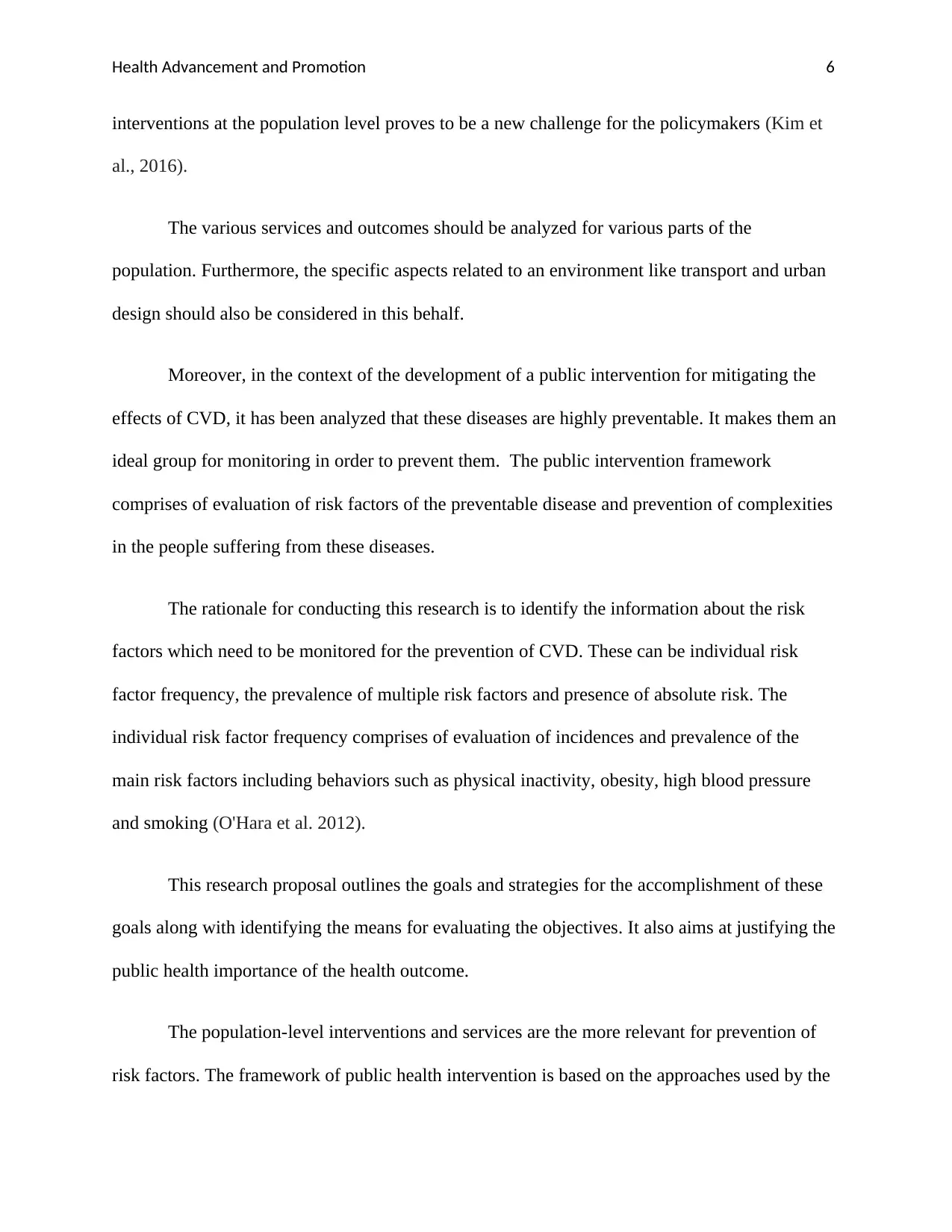
Health Advancement and Promotion 6
interventions at the population level proves to be a new challenge for the policymakers (Kim et
al., 2016).
The various services and outcomes should be analyzed for various parts of the
population. Furthermore, the specific aspects related to an environment like transport and urban
design should also be considered in this behalf.
Moreover, in the context of the development of a public intervention for mitigating the
effects of CVD, it has been analyzed that these diseases are highly preventable. It makes them an
ideal group for monitoring in order to prevent them. The public intervention framework
comprises of evaluation of risk factors of the preventable disease and prevention of complexities
in the people suffering from these diseases.
The rationale for conducting this research is to identify the information about the risk
factors which need to be monitored for the prevention of CVD. These can be individual risk
factor frequency, the prevalence of multiple risk factors and presence of absolute risk. The
individual risk factor frequency comprises of evaluation of incidences and prevalence of the
main risk factors including behaviors such as physical inactivity, obesity, high blood pressure
and smoking (O'Hara et al. 2012).
This research proposal outlines the goals and strategies for the accomplishment of these
goals along with identifying the means for evaluating the objectives. It also aims at justifying the
public health importance of the health outcome.
The population-level interventions and services are the more relevant for prevention of
risk factors. The framework of public health intervention is based on the approaches used by the
interventions at the population level proves to be a new challenge for the policymakers (Kim et
al., 2016).
The various services and outcomes should be analyzed for various parts of the
population. Furthermore, the specific aspects related to an environment like transport and urban
design should also be considered in this behalf.
Moreover, in the context of the development of a public intervention for mitigating the
effects of CVD, it has been analyzed that these diseases are highly preventable. It makes them an
ideal group for monitoring in order to prevent them. The public intervention framework
comprises of evaluation of risk factors of the preventable disease and prevention of complexities
in the people suffering from these diseases.
The rationale for conducting this research is to identify the information about the risk
factors which need to be monitored for the prevention of CVD. These can be individual risk
factor frequency, the prevalence of multiple risk factors and presence of absolute risk. The
individual risk factor frequency comprises of evaluation of incidences and prevalence of the
main risk factors including behaviors such as physical inactivity, obesity, high blood pressure
and smoking (O'Hara et al. 2012).
This research proposal outlines the goals and strategies for the accomplishment of these
goals along with identifying the means for evaluating the objectives. It also aims at justifying the
public health importance of the health outcome.
The population-level interventions and services are the more relevant for prevention of
risk factors. The framework of public health intervention is based on the approaches used by the
Paraphrase This Document
Need a fresh take? Get an instant paraphrase of this document with our AI Paraphraser
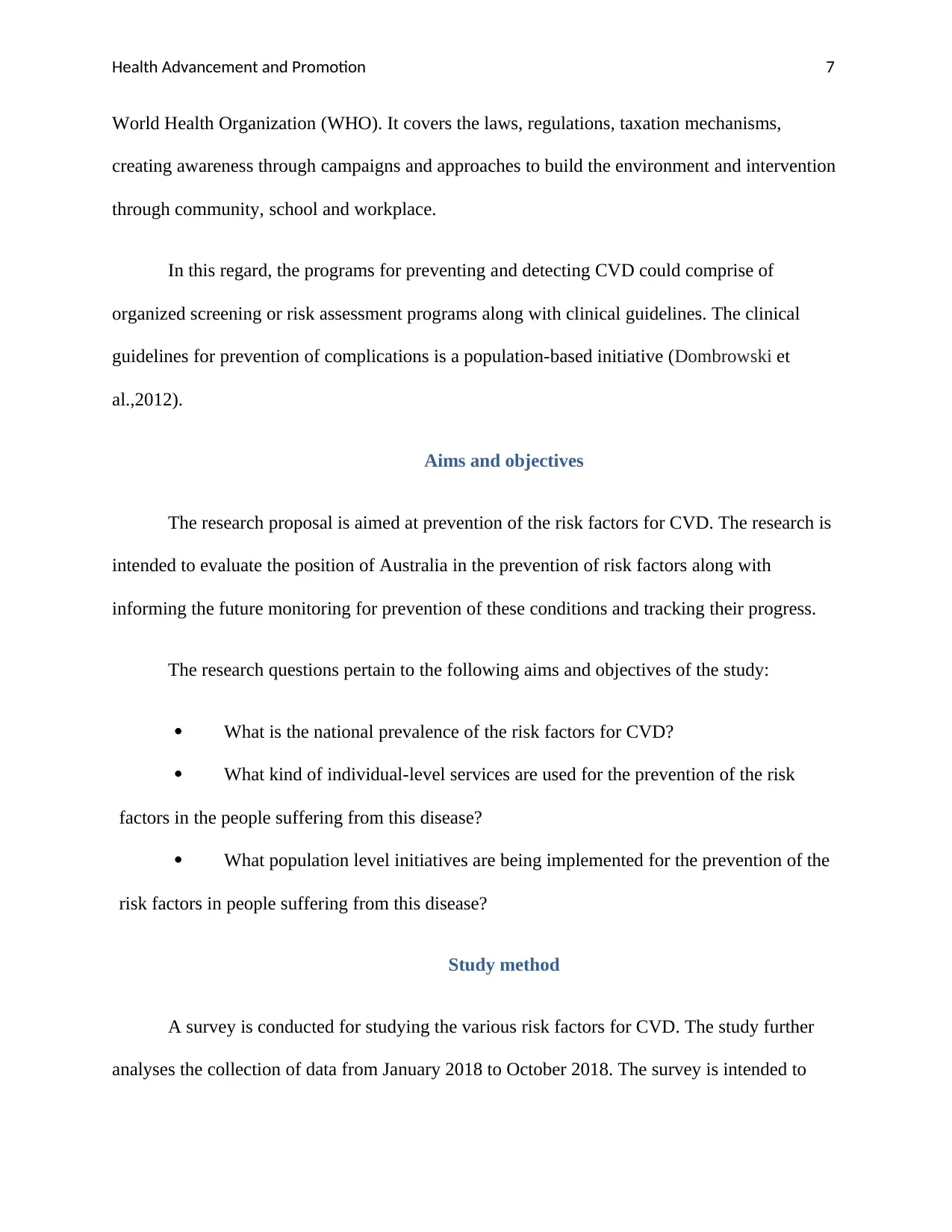
Health Advancement and Promotion 7
World Health Organization (WHO). It covers the laws, regulations, taxation mechanisms,
creating awareness through campaigns and approaches to build the environment and intervention
through community, school and workplace.
In this regard, the programs for preventing and detecting CVD could comprise of
organized screening or risk assessment programs along with clinical guidelines. The clinical
guidelines for prevention of complications is a population-based initiative (Dombrowski et
al.,2012).
Aims and objectives
The research proposal is aimed at prevention of the risk factors for CVD. The research is
intended to evaluate the position of Australia in the prevention of risk factors along with
informing the future monitoring for prevention of these conditions and tracking their progress.
The research questions pertain to the following aims and objectives of the study:
What is the national prevalence of the risk factors for CVD?
What kind of individual-level services are used for the prevention of the risk
factors in the people suffering from this disease?
What population level initiatives are being implemented for the prevention of the
risk factors in people suffering from this disease?
Study method
A survey is conducted for studying the various risk factors for CVD. The study further
analyses the collection of data from January 2018 to October 2018. The survey is intended to
World Health Organization (WHO). It covers the laws, regulations, taxation mechanisms,
creating awareness through campaigns and approaches to build the environment and intervention
through community, school and workplace.
In this regard, the programs for preventing and detecting CVD could comprise of
organized screening or risk assessment programs along with clinical guidelines. The clinical
guidelines for prevention of complications is a population-based initiative (Dombrowski et
al.,2012).
Aims and objectives
The research proposal is aimed at prevention of the risk factors for CVD. The research is
intended to evaluate the position of Australia in the prevention of risk factors along with
informing the future monitoring for prevention of these conditions and tracking their progress.
The research questions pertain to the following aims and objectives of the study:
What is the national prevalence of the risk factors for CVD?
What kind of individual-level services are used for the prevention of the risk
factors in the people suffering from this disease?
What population level initiatives are being implemented for the prevention of the
risk factors in people suffering from this disease?
Study method
A survey is conducted for studying the various risk factors for CVD. The study further
analyses the collection of data from January 2018 to October 2018. The survey is intended to
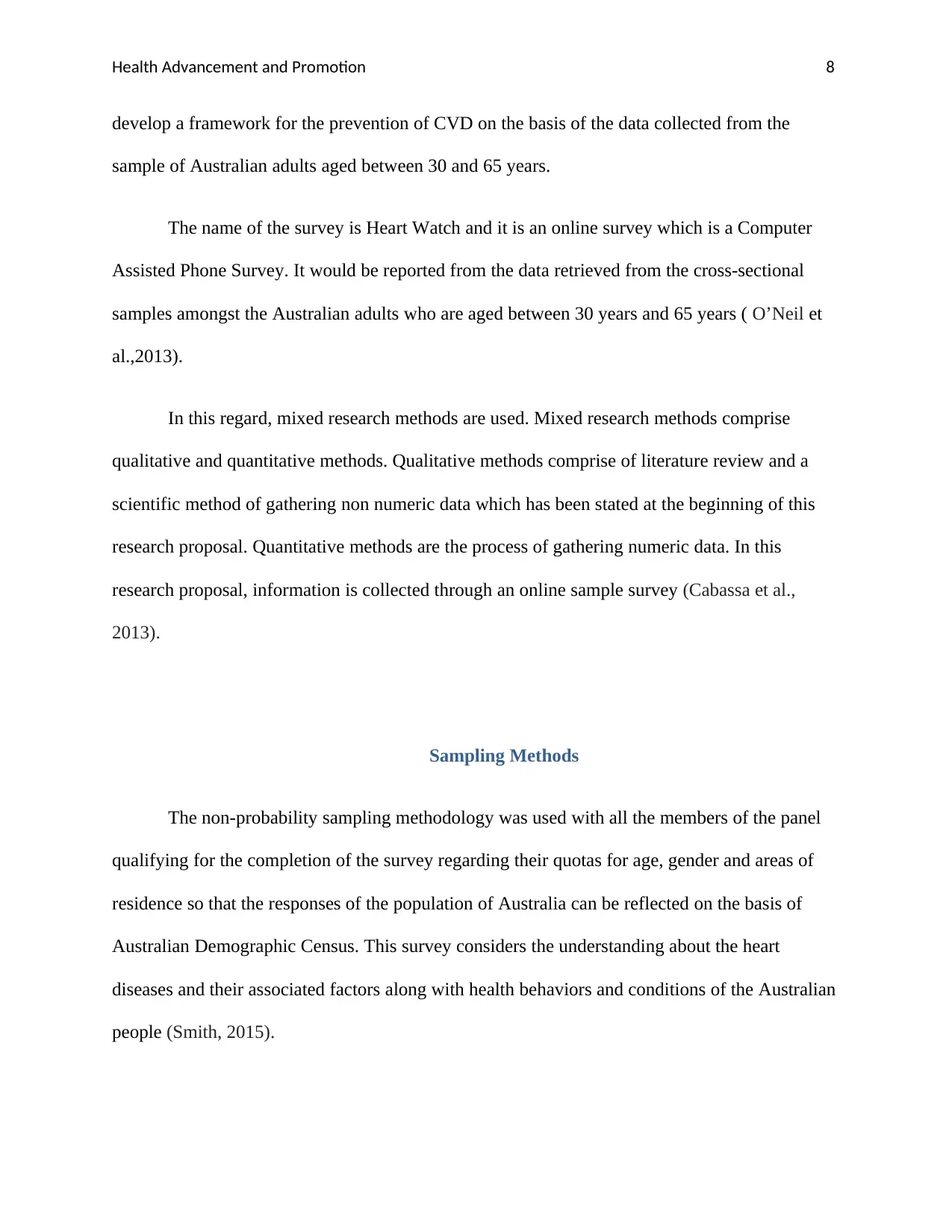
Health Advancement and Promotion 8
develop a framework for the prevention of CVD on the basis of the data collected from the
sample of Australian adults aged between 30 and 65 years.
The name of the survey is Heart Watch and it is an online survey which is a Computer
Assisted Phone Survey. It would be reported from the data retrieved from the cross-sectional
samples amongst the Australian adults who are aged between 30 years and 65 years ( O’Neil et
al.,2013).
In this regard, mixed research methods are used. Mixed research methods comprise
qualitative and quantitative methods. Qualitative methods comprise of literature review and a
scientific method of gathering non numeric data which has been stated at the beginning of this
research proposal. Quantitative methods are the process of gathering numeric data. In this
research proposal, information is collected through an online sample survey (Cabassa et al.,
2013).
Sampling Methods
The non-probability sampling methodology was used with all the members of the panel
qualifying for the completion of the survey regarding their quotas for age, gender and areas of
residence so that the responses of the population of Australia can be reflected on the basis of
Australian Demographic Census. This survey considers the understanding about the heart
diseases and their associated factors along with health behaviors and conditions of the Australian
people (Smith, 2015).
develop a framework for the prevention of CVD on the basis of the data collected from the
sample of Australian adults aged between 30 and 65 years.
The name of the survey is Heart Watch and it is an online survey which is a Computer
Assisted Phone Survey. It would be reported from the data retrieved from the cross-sectional
samples amongst the Australian adults who are aged between 30 years and 65 years ( O’Neil et
al.,2013).
In this regard, mixed research methods are used. Mixed research methods comprise
qualitative and quantitative methods. Qualitative methods comprise of literature review and a
scientific method of gathering non numeric data which has been stated at the beginning of this
research proposal. Quantitative methods are the process of gathering numeric data. In this
research proposal, information is collected through an online sample survey (Cabassa et al.,
2013).
Sampling Methods
The non-probability sampling methodology was used with all the members of the panel
qualifying for the completion of the survey regarding their quotas for age, gender and areas of
residence so that the responses of the population of Australia can be reflected on the basis of
Australian Demographic Census. This survey considers the understanding about the heart
diseases and their associated factors along with health behaviors and conditions of the Australian
people (Smith, 2015).
⊘ This is a preview!⊘
Do you want full access?
Subscribe today to unlock all pages.

Trusted by 1+ million students worldwide
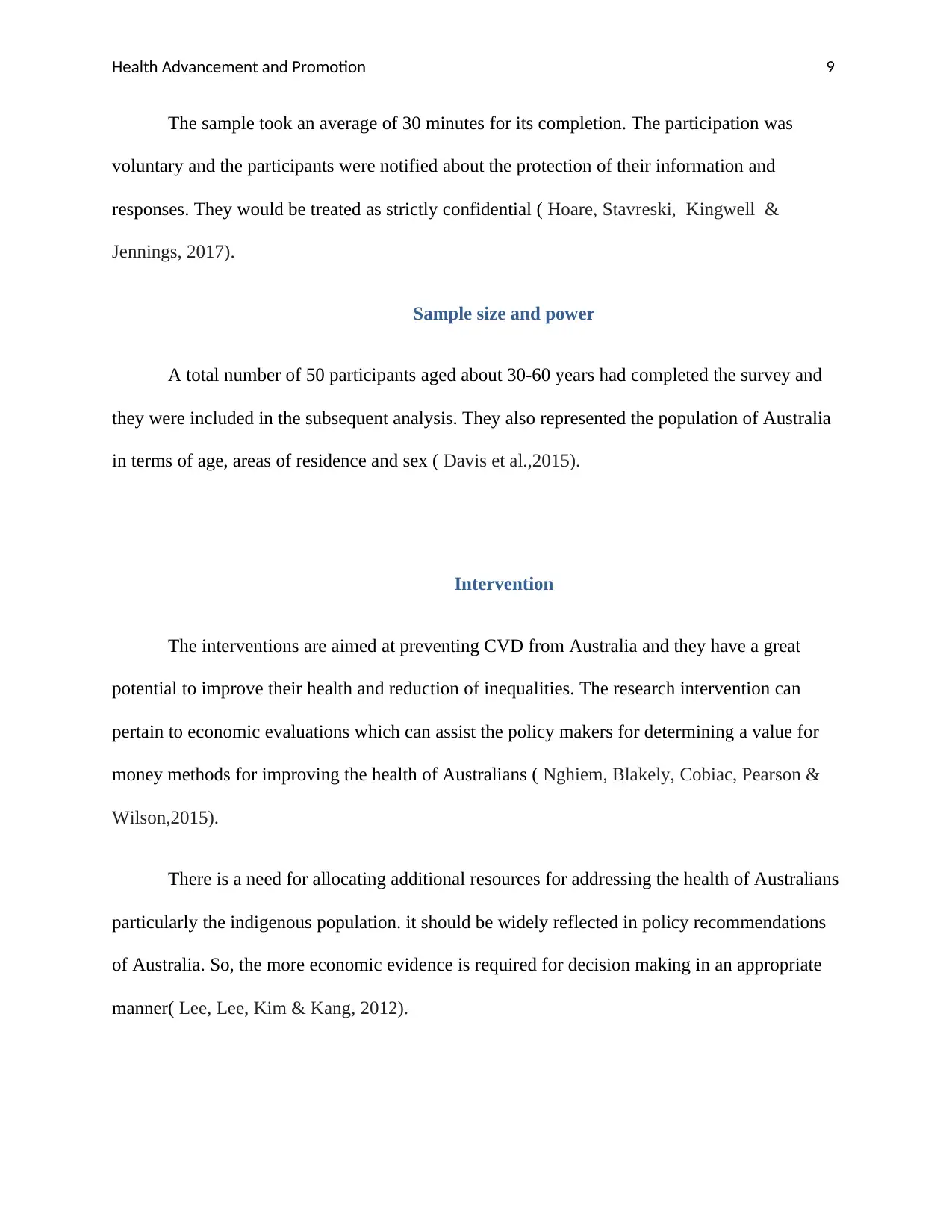
Health Advancement and Promotion 9
The sample took an average of 30 minutes for its completion. The participation was
voluntary and the participants were notified about the protection of their information and
responses. They would be treated as strictly confidential ( Hoare, Stavreski, Kingwell &
Jennings, 2017).
Sample size and power
A total number of 50 participants aged about 30-60 years had completed the survey and
they were included in the subsequent analysis. They also represented the population of Australia
in terms of age, areas of residence and sex ( Davis et al.,2015).
Intervention
The interventions are aimed at preventing CVD from Australia and they have a great
potential to improve their health and reduction of inequalities. The research intervention can
pertain to economic evaluations which can assist the policy makers for determining a value for
money methods for improving the health of Australians ( Nghiem, Blakely, Cobiac, Pearson &
Wilson,2015).
There is a need for allocating additional resources for addressing the health of Australians
particularly the indigenous population. it should be widely reflected in policy recommendations
of Australia. So, the more economic evidence is required for decision making in an appropriate
manner( Lee, Lee, Kim & Kang, 2012).
The sample took an average of 30 minutes for its completion. The participation was
voluntary and the participants were notified about the protection of their information and
responses. They would be treated as strictly confidential ( Hoare, Stavreski, Kingwell &
Jennings, 2017).
Sample size and power
A total number of 50 participants aged about 30-60 years had completed the survey and
they were included in the subsequent analysis. They also represented the population of Australia
in terms of age, areas of residence and sex ( Davis et al.,2015).
Intervention
The interventions are aimed at preventing CVD from Australia and they have a great
potential to improve their health and reduction of inequalities. The research intervention can
pertain to economic evaluations which can assist the policy makers for determining a value for
money methods for improving the health of Australians ( Nghiem, Blakely, Cobiac, Pearson &
Wilson,2015).
There is a need for allocating additional resources for addressing the health of Australians
particularly the indigenous population. it should be widely reflected in policy recommendations
of Australia. So, the more economic evidence is required for decision making in an appropriate
manner( Lee, Lee, Kim & Kang, 2012).
Paraphrase This Document
Need a fresh take? Get an instant paraphrase of this document with our AI Paraphraser
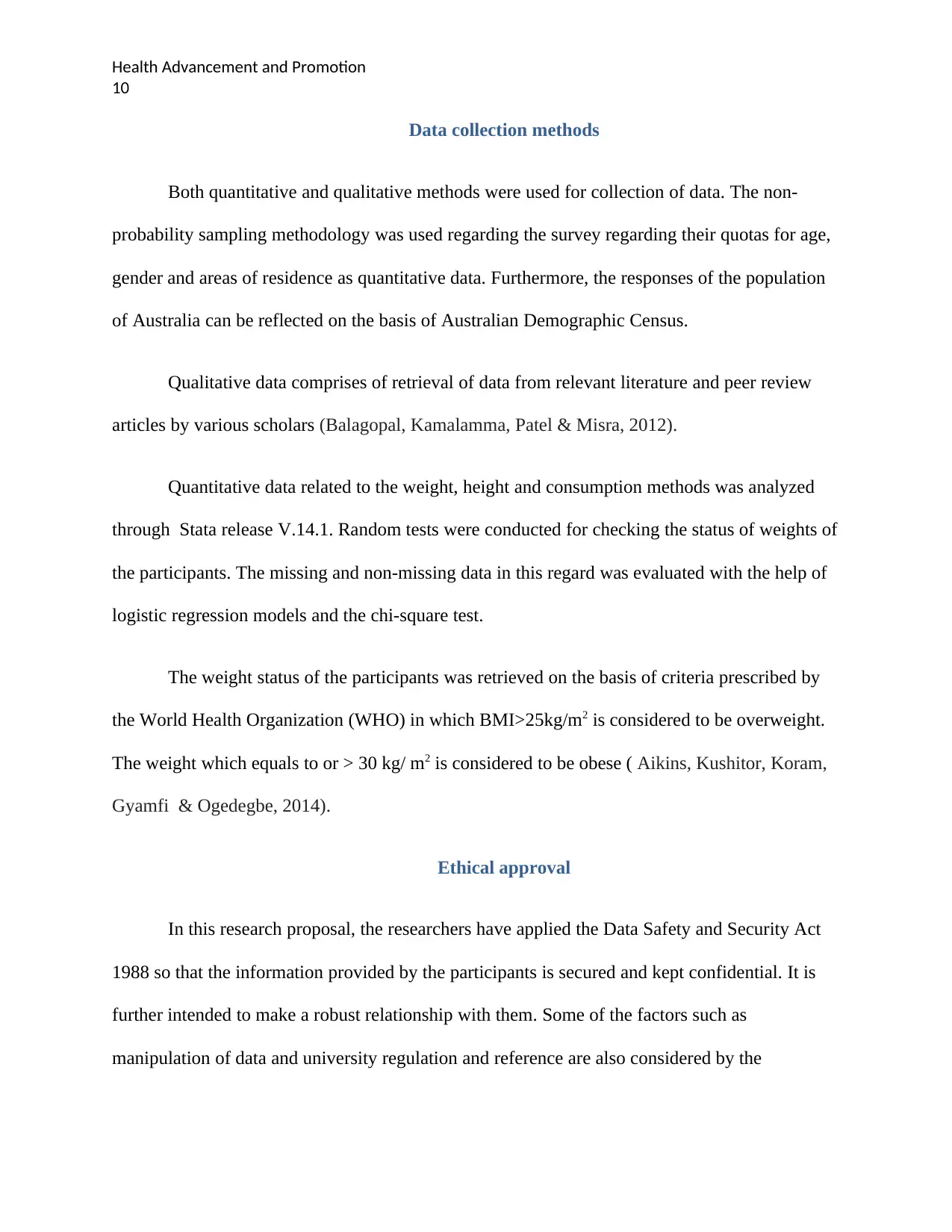
Health Advancement and Promotion
10
Data collection methods
Both quantitative and qualitative methods were used for collection of data. The non-
probability sampling methodology was used regarding the survey regarding their quotas for age,
gender and areas of residence as quantitative data. Furthermore, the responses of the population
of Australia can be reflected on the basis of Australian Demographic Census.
Qualitative data comprises of retrieval of data from relevant literature and peer review
articles by various scholars (Balagopal, Kamalamma, Patel & Misra, 2012).
Quantitative data related to the weight, height and consumption methods was analyzed
through Stata release V.14.1. Random tests were conducted for checking the status of weights of
the participants. The missing and non-missing data in this regard was evaluated with the help of
logistic regression models and the chi-square test.
The weight status of the participants was retrieved on the basis of criteria prescribed by
the World Health Organization (WHO) in which BMI>25kg/m2 is considered to be overweight.
The weight which equals to or > 30 kg/ m2 is considered to be obese ( Aikins, Kushitor, Koram,
Gyamfi & Ogedegbe, 2014).
Ethical approval
In this research proposal, the researchers have applied the Data Safety and Security Act
1988 so that the information provided by the participants is secured and kept confidential. It is
further intended to make a robust relationship with them. Some of the factors such as
manipulation of data and university regulation and reference are also considered by the
10
Data collection methods
Both quantitative and qualitative methods were used for collection of data. The non-
probability sampling methodology was used regarding the survey regarding their quotas for age,
gender and areas of residence as quantitative data. Furthermore, the responses of the population
of Australia can be reflected on the basis of Australian Demographic Census.
Qualitative data comprises of retrieval of data from relevant literature and peer review
articles by various scholars (Balagopal, Kamalamma, Patel & Misra, 2012).
Quantitative data related to the weight, height and consumption methods was analyzed
through Stata release V.14.1. Random tests were conducted for checking the status of weights of
the participants. The missing and non-missing data in this regard was evaluated with the help of
logistic regression models and the chi-square test.
The weight status of the participants was retrieved on the basis of criteria prescribed by
the World Health Organization (WHO) in which BMI>25kg/m2 is considered to be overweight.
The weight which equals to or > 30 kg/ m2 is considered to be obese ( Aikins, Kushitor, Koram,
Gyamfi & Ogedegbe, 2014).
Ethical approval
In this research proposal, the researchers have applied the Data Safety and Security Act
1988 so that the information provided by the participants is secured and kept confidential. It is
further intended to make a robust relationship with them. Some of the factors such as
manipulation of data and university regulation and reference are also considered by the
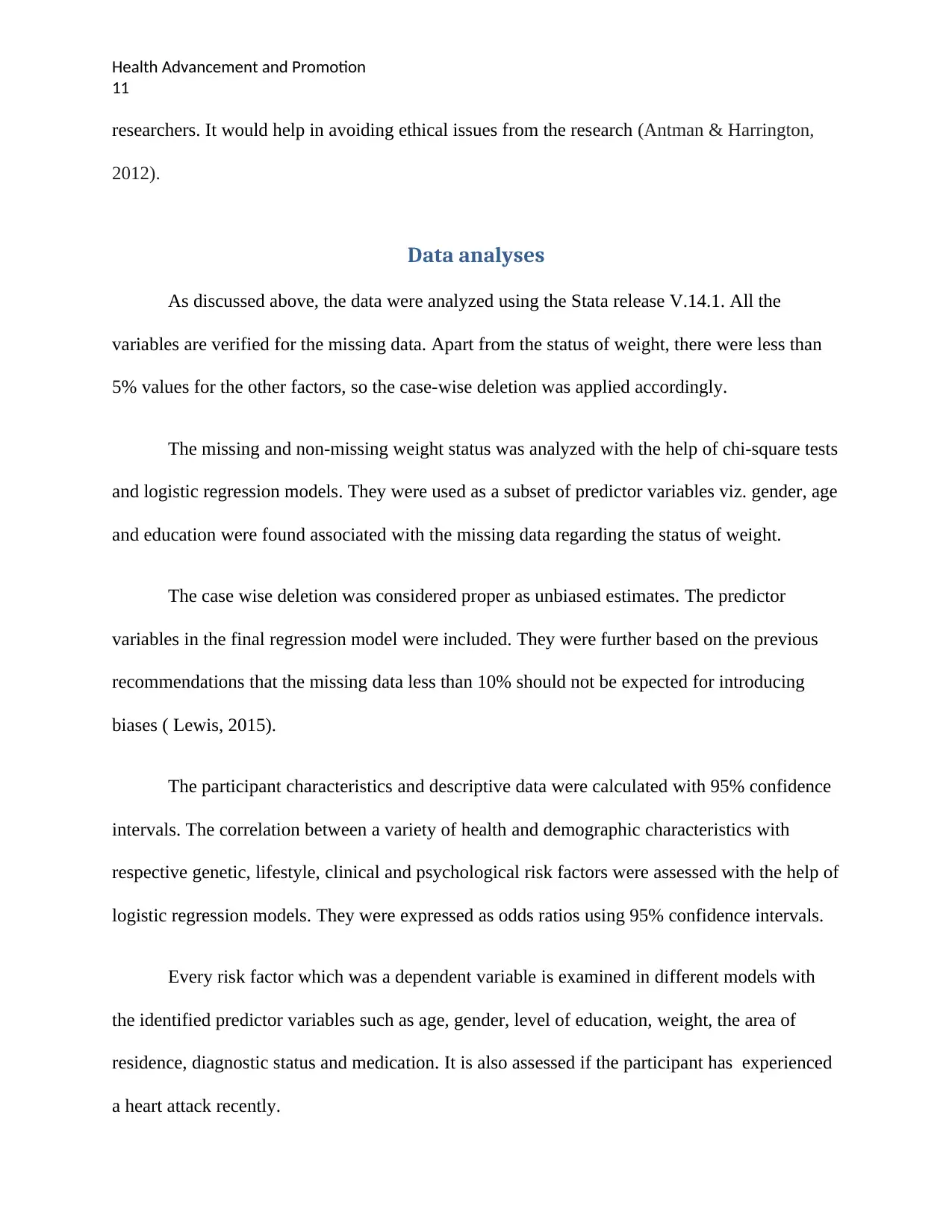
Health Advancement and Promotion
11
researchers. It would help in avoiding ethical issues from the research (Antman & Harrington,
2012).
Data analyses
As discussed above, the data were analyzed using the Stata release V.14.1. All the
variables are verified for the missing data. Apart from the status of weight, there were less than
5% values for the other factors, so the case-wise deletion was applied accordingly.
The missing and non-missing weight status was analyzed with the help of chi-square tests
and logistic regression models. They were used as a subset of predictor variables viz. gender, age
and education were found associated with the missing data regarding the status of weight.
The case wise deletion was considered proper as unbiased estimates. The predictor
variables in the final regression model were included. They were further based on the previous
recommendations that the missing data less than 10% should not be expected for introducing
biases ( Lewis, 2015).
The participant characteristics and descriptive data were calculated with 95% confidence
intervals. The correlation between a variety of health and demographic characteristics with
respective genetic, lifestyle, clinical and psychological risk factors were assessed with the help of
logistic regression models. They were expressed as odds ratios using 95% confidence intervals.
Every risk factor which was a dependent variable is examined in different models with
the identified predictor variables such as age, gender, level of education, weight, the area of
residence, diagnostic status and medication. It is also assessed if the participant has experienced
a heart attack recently.
11
researchers. It would help in avoiding ethical issues from the research (Antman & Harrington,
2012).
Data analyses
As discussed above, the data were analyzed using the Stata release V.14.1. All the
variables are verified for the missing data. Apart from the status of weight, there were less than
5% values for the other factors, so the case-wise deletion was applied accordingly.
The missing and non-missing weight status was analyzed with the help of chi-square tests
and logistic regression models. They were used as a subset of predictor variables viz. gender, age
and education were found associated with the missing data regarding the status of weight.
The case wise deletion was considered proper as unbiased estimates. The predictor
variables in the final regression model were included. They were further based on the previous
recommendations that the missing data less than 10% should not be expected for introducing
biases ( Lewis, 2015).
The participant characteristics and descriptive data were calculated with 95% confidence
intervals. The correlation between a variety of health and demographic characteristics with
respective genetic, lifestyle, clinical and psychological risk factors were assessed with the help of
logistic regression models. They were expressed as odds ratios using 95% confidence intervals.
Every risk factor which was a dependent variable is examined in different models with
the identified predictor variables such as age, gender, level of education, weight, the area of
residence, diagnostic status and medication. It is also assessed if the participant has experienced
a heart attack recently.
⊘ This is a preview!⊘
Do you want full access?
Subscribe today to unlock all pages.

Trusted by 1+ million students worldwide
1 out of 27
Related Documents
Your All-in-One AI-Powered Toolkit for Academic Success.
+13062052269
info@desklib.com
Available 24*7 on WhatsApp / Email
![[object Object]](/_next/static/media/star-bottom.7253800d.svg)
Unlock your academic potential
Copyright © 2020–2025 A2Z Services. All Rights Reserved. Developed and managed by ZUCOL.




